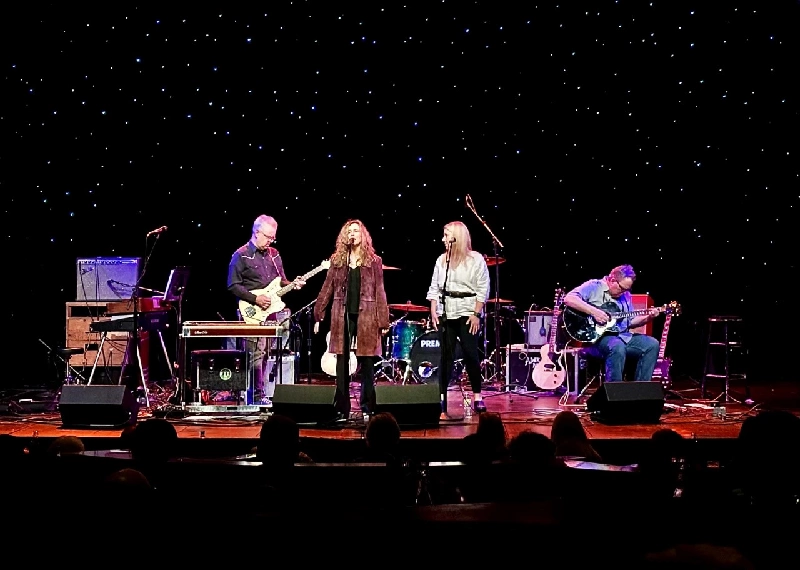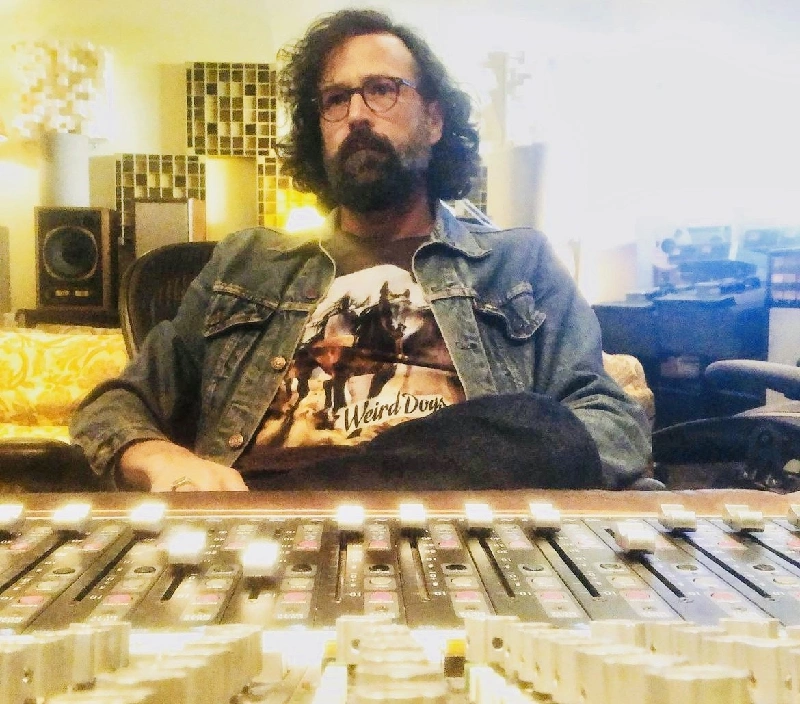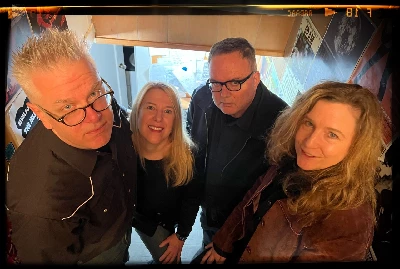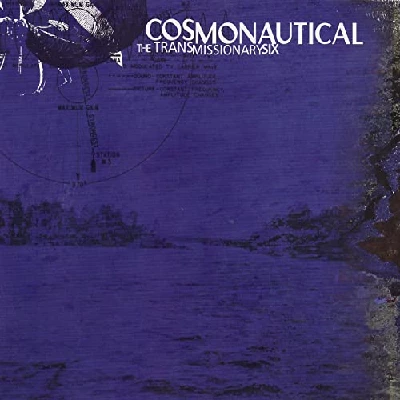PB: Robert Fisher in the interviews we did with him talked a lot about 'happy accidents' and 'coincidences', things which weren't initially planned coming along or arising. Was there a lot of that on this album, especially as it wasn't planned initially as an album? At what point did you start talking about making a LP? PA: Gosh, I really don’t know. Once we had one song - which was all our initial goal was - we decided to do another song. And then we thought, well, if we do a third, it would be a nice three-song digital EP. But then we picked up some speed and had five. Once we got that far, we just kept going, and figured we’d know when to stop, when we had a larger group of songs that fit well together. We decided to put it on CD, which isn’t too popular these days, but people kept asking. I’m happy to say we didn’t succumb to the temptation of just going on and on, until we had an hour of music just because we could on a CD. Once we had a nice group, we called it good. I wouldn’t say we had too many accidental happenings that transformed the songs. For us, it was more keeping an open mind and leaving room for the songs to come together without a preconceived notion of what the “final” version would sound like. When Jon would take his turn in the recording process and add electric guitar, I had no idea at all what he was going to do; no parts were written, and he’d play what he thought would work well and elevate the song. It was pretty fun to be surprised like that as we went from song to song and everyone having a lot of freedom. When we started this project/CD, we had no idea at all we’d be asking Deni for strings, or Chris Cacavas for electric piano. Not even a passing thought. But as we worked on each song, we’d see if there was room for an additional element, something that we likely wouldn’t have thought of, to be added by a guest. PB: The first two songs on the album are ‘Point Defiance Landfall’ and ‘The New New Thing’. Was there an intentional symbolism with starting the album with those tracks, the first ones that you had recorded since your return? PA: When it came time to sequence the record, I looked at the list of songs, and they were listed in my notes in the order we did them. I was looking at ‘Point Defiance Landfall’ and ‘The New New Thing’ and ‘Sudden Movements’ - the first three we did, in that order - and thought, “Hmm, that would work!” And as it ended up, with the exception of ‘The Night Won’t’, a gauzy little lullaby that closes the record, we did end up sequencing them in pretty much the order we wrote and recorded them. PB: 'The Night Won't' recalls The Velvet Underground's 'After Hours' in that it appears at the very end of the record and is very stark and simple. It is similarly very short, lasting barely two minutes. and serves as a coda for the rest of the record. Was that your intention with it? PA: In the beginning, I remember thinking it would be great if, in the middle of several full songs, we had something that felt more like a fragment. The verse appears once, the chorus appears once, and then it just kind of drifts away. But when we got to recording and mixing the song, it just had this pillowy quality… and felt like it’d be a great way to end the album; a very gentle goodnight. Y’know, thanks for taking this journey with us. Once we had that idea, it was difficult to picture placing it anywhere else. PB: The initial run of the album comes with a five song EP, which was recorded on February 19th this year and which appears in a plain cardboard sleeve in which the tracks are not listed. Why did you decide to do that? PA: We just thought it would be nice to add a little something extra for folks who pre-ordered; it wasn’t anything more than that. We seem to get a nice quartet vibe going when it’s Terri, Jon, Carolyn and I, and we decided to set up in Jon’s studio and play a brief set of what that sounds like. It was pressed as one single twenty-five minute track rather than dividing it out by the five songs, to take the ‘live experience’ a step further; you can’t “shuffle” songs when attending someone’s show, and we wanted to replicate that - a band with a setlist, where you put thought into the sequence and execute it as planned, just as you would at a gig. So it was a nice contrast to ‘Often Sometimes Rarely Never’ in that way, which of course you can listen to any way you want to! PB: Being in a band can be really draining and hard work, all that striving for creativity and even at a small level touring and having to promote yourself. It sounds like you stopped The Transmissionary Six in 2012 while you were still having fun, which was perhaps less the case with Willard Grant Conspiracy, which by the time you left from what you have said before you were completely burned out and exhausted. PA: If that’s what I said, I was - in hindsight - being a bit melodramatic; I was ready to step aside, but I’m certainly grateful for the experience overall. With Robert Fisher in Willard Grant Conspiracy, Terri in The Transmissionary Six and Chris Eckman with The Walkabouts, I’ve had the opportunity to collaborate with three writers who really have something special. They aren’t similar, per se, but each really has a voice - figuratively, but I guess literally as well. It’s been pretty rewarding to write and collaborate with writers like that. I mean, how many people are in bands for years, and never get to experience that? It feels somehow like a gift I was given. Or luck. Probably a combination of both! PB: You wrote music with Robert Fisher, who died in 2017, in Laughing Academy and The Flower Tamers as well as Willard Grant Conspiracy? What do you think you learnt primarily from him musically and about songwriting as his main musical collaborator for some years? PA: I think the main thing I took away from writing songs with Robert was not only how good he was at constructing a narrative, but how fast. It’s as if he had some secret backlog of lyrics ready to go. I’d be sitting around playing guitar, and he’d say “keep playing that”, pull out his notebook, and start scrawling. And what he came up with was just so good - immediately! There was barely any rewriting or editing; he could just come up with interesting, really moving narratives seemingly on the spot, just reacting to a chord change I had made up mere minutes ago. If anything, it solidified for me what was possible when co-writing. He later composed songs by himself, of course, and his gift remained obvious. But it was the first time in a band I had experienced a spark like that, and it made me go looking for that level of alchemy in future projects. After I had a break from the band, I asked him about re-joining, participating a bit, and he said no. I never got a straight answer why; he simply, literally, said “no”. That was a lost opportunity, not having the chance to do some more writing together, but his outlook was seemingly that if you leave, you’re out. It’s something that confuses and saddens me, even to this day; there was an element of punishment to it. I guess you could say that was a learning experience as well. PB: In contrast to Robert, what are the main things you have learnt about songwriting and taken from collaborating with Chris and Terri? PA: With Terri, we have much the same method as I had with Robert in that I come up with chord changes and an arrangement and a vibe - to start with - and she takes it away, and then comes up with lyrics that are interesting and evocative, and take the song to its next stage. Robert was a storyteller; Terri is a scene setter. She’s highly descriptive and often mysterious in what she’s getting at. I really enjoy her inventive approach. She leaves a lot of room for the listener to complete the song with their own interpretation of what’s going on. It’s not inscrutable; there’s always a way in. And it may differ from one listener to the next. My role working with Chris has been much different; after years spent with Willard Grant Conspiracy and The Transmissionary Six kicking off the songs with a spare acoustic demo, that wasn’t my role at all in The Walkabouts. With Chris and The Walkabouts, he’d bring in complete songs, and as a band we’d work out how to best render them. My role on electric guitar was much more to add colour and texture. Occasionally I’d have ideas that would pull a song in a certain way, and he was always very open to that - very generous in the leeway he allowed the rest of the band in terms of painting the songs with additional melody, texture, dissonance… whatever comes up. He’s very secure in who he is and what he does as a writer; that leaves the door open to entertaining all kinds of ideas that may not have been part of how he originally envisioned the song. It was such a treat to add colour to songs in an atmosphere like that, and I feel lucky to have done a trio tour with him, adding tasteful colour to songs on electric guitar - as well as The Walkabouts album and tours, of course. In both scenarios he was, again, very generous. PB: And what do you think that you have been able to primarily bring to them? PA: Oh boy, it’s hard to say. It’s hard to size yourself up, you know? I’ll go ahead and say I hope I’m good at working with a song as it’s coming together, and hearing not only the strong aspects but also areas where there might be room to try something else that will complement and serve the song. Creativity that honours the song’s intent, and a willingness to find those spots without overdoing it. I do think you can shepherd a song to conclusion while still making sure you stay out of the way and allow other folks to contribute ideas; I mean, those ideas often end up so valuable! My favourite part of the song is the mix, where the mixing engineer/producer sculpts the final song. That’s really exciting. If I come up with something that gets used and really elevates the song, that’s still pretty cool even after years of writing and playing! PB: You have made videos for three of the songs on the album. The first two, 'Point Defiance Landfall' and 'The New New Thing', come from the same place in that they show lots of close-ups of musical equipment and road signs and markings and the band members appear briefly in one shot cameos. Were they made back-to-back, and directed by the same person? PA: They were both made by me, just using clips taken with the cheap ‘8mm’app on my phone. There is also some historical footage mixed in of a storm pulling a bridge apart, but again that was just finding something evocative in a free online film archive and literally pointing my phone camera at a laptop screen - you can even see my reflection! It was just a case of wandering around town, and being in Jon’s studio recording, and taking a hundred or so two-or-three second clips, and then a friend just stitched them together. It could not have been lower budget, but the hope was that the homespun quality would be appealing. I don’t know if that worked… but that was how they came to be! PB: The last one for 'No One and Done' is animated. Who directed that? PA: After a couple of ‘home movie’ type clips, we were thinking it would be cool to have a really nice one for ‘No One And Done’. I happened to come across Anik Hamud online, who did illustrated lyric videos. He had a short demo clip, and I loved the purple on black illustration he was using, with the lyrics appearing in white. We sent him the song and the lyrics, and he sent back a video. We asked for just a few scenes that literally lined up with the lyrics - the angelic halo on “yellow halo disease”, the women’s dress hanging on the line to dry for “my cower dress”… beyond that, he just did his thing. It was pretty exciting to see the final video. The record had been mastered by that time, by Jeff and Maria at Peerless Mastering in Boston, and that song is one that especially benefited from the mastering process - it just took it to another level. The detail Jeff and Maria brought out on that song is really something. We just kept watching the video when we got it, as fans would, with Terri’s lyrics floating over the illustration and a great sounding track. It was a convergence; we had just the right song for a lyric video, and Anik was right up our alley vibe-wise. It’ll outlast us as an active band, and it’s pretty cool knowing it’ll still be floating around out there. PB: Will there be more videos for the other tracks? PA: I don’t think so… three seems good. But who knows? Anything could happen. PB: There is a special Dolby Atmos version of ‘Often Something Rarely Never’. Could you say more about that? PA: Matt Brown, who mixed the record, and Jeff Lipton, who mastered it, worked together to create a Dolby Atmos/spatial audio version of the album that went online for streaming back on the April 1 release date. It’s available on Tidal and Apple Music, the only two streaming services that offer Dolby Atmos. The others haven’t caught up yet. It’s definitely where music is headed. I don’t know if you are a fan of Dolby Atmos, but it’s immersive when listening on headphones that support it. There are no horizontal or vertical constraints in the stereo field when mixing the album, so the instruments are all around you - including above you and behind you! I visited Boston to watch Jeff complete the two-day Atmos process, just because I wanted to see how it’s done. Do you remember when “surround sound” came to movie theatres? I liken it a bit to that, as a quick reference. PB: What other plans do you have for the future with The Transmissionary Six? PA: We’ve done a couple of live shows to mark the emergence of the new record; one in a bookstore, and one in a record shop. We’re playing in a lovely hideaway of a theatre next weekend. As a quartet, we’re pretty quiet, so we’re always on the lookout for alternative spaces. We tend to get drowned out in bars! We’d also really like to do an online livestream show from Jon’s studio. Just the quartet - Terri, Jon, Carolyn and I. Something very intimate. That would be so nice for all our European friends that last saw us on tour over seventeen years ago, are still in touch, and ordered the CD. Not to mention our UK friends and supporters, who’ve never seen us play live at all! It’d be a way to connect - and really, at the end of the day, that’s what it’s all about. PB: Thank you
Band Links:-
https://www.facebook.com/TransmissionarySix/https://thetransmissionarysix.bandcamp.com/
Play in YouTube:-
Picture Gallery:-


Matt Brown at the mixing desk. Photo: Space Ranch Studios IG

Jeff Lipton polishing the immersive Dolby Atmos spatial audio remix of 'Often Sometimes Rarely Never' at Peerless Mastering, February 2023. Photo: Paul Austin
intro
In the second part of our interview with guitarist Paul Austin, John Clarkson talks to him about songwriting with Robert Fisher from Willard Grant Conspiracy, Chris Eckman from The Walkabouts and Terri Pearson from The Transmissionary Six, and The Transmissionary Six's unusual new videos.
interviews |
|
Interview with Paul Austin Part 1 (2023) |

|
| In the first part of a two part interview, both parts which we are running consecutively, guitarist Paul Austin talks to John Clarkson about the reformation of his band The Transmissionary Six after a decade-long absence, and their new album, 'Often Sometimes Rarely Never'. |
| Interview with Paul Austin and Terri Moeller (2003) |
| Interview with Paul Austin (2002) |
reviews |
|
Cosmonautical (2008) |

|
| Uplifting and epic-sounding chamber pop on fifth album from previously melancholic Seattle-based band the Transmissionary Six, which is their most accessible album to date |
| Radar (2006) |
| Get Down (2005) |
| Go Fast for Cheap (2003) |
| Desoto (2002) |
| Transmissionary Six (2002) |
most viewed articles
current edition
Carl Ewens - David Bowie 1964 to 1982 On Track: Every Album, Every SongArmory Show - Interview with Richard Jobson
John McKay - Interview
Colin Blunstone - Thalia Hall, Chicago, 16/7/2025
Billie Eilish - O2 Arena, London, 10/7/2025
Bathers - Photoscapes 1
Visor Fest - Valencia, Spain, 26/9/2025...27/9/2025
Loft - Interview
Sir Tim Rice - Interview
Robert Forster - Interview
previous editions
Manic Street Preachers - (Gig of a Lifetime) Millennium Stadium, Cardiff, December 1999Heavenly - P.U.N.K. Girl EP
Beautiful South - Ten Songs That Made Me Love...
Oasis - Oasis, Earl's Court, London, 1995
Peter Perrett - In Dreams Begin Responsibilities Interview Part One
Boomtown Rats - Ten Songs That Made Me Love....
Coldplay - Wembley Arena. London, 16/8/2022
Prolapse - Interview
Pixies - Ten Songs That Made Me Love...
Trudie Myerscough-Harris - Interview
most viewed reviews
current edition
Davey Woodward - Mumbo in the JumboSick Man of Europe - The Sick Man of Europe
Lucy Spraggan - Other Sides of the Moon
Amy Macdonald - Is This What You've Been Waiting For?
Phew, Erika Kobayashi,, Dieter Moebius - Radium Girls
Bush - I Beat Loneliness
Suzanne Vega - Flying With Angels
Alice Cooper - The Revenge of Alice Cooper
Cynthia Erivo - I Forgive You
Blueboy - 2
Pennyblackmusic Regular Contributors
Adrian Janes
Amanda J. Window
Andrew Twambley
Anthony Dhanendran
Benjamin Howarth
Cila Warncke
Daniel Cressey
Darren Aston
Dastardly
Dave Goodwin
Denzil Watson
Dominic B. Simpson
Eoghan Lyng
Fiona Hutchings
Harry Sherriff
Helen Tipping
Jamie Rowland
John Clarkson
Julie Cruickshank
Kimberly Bright
Lisa Torem
Maarten Schiethart